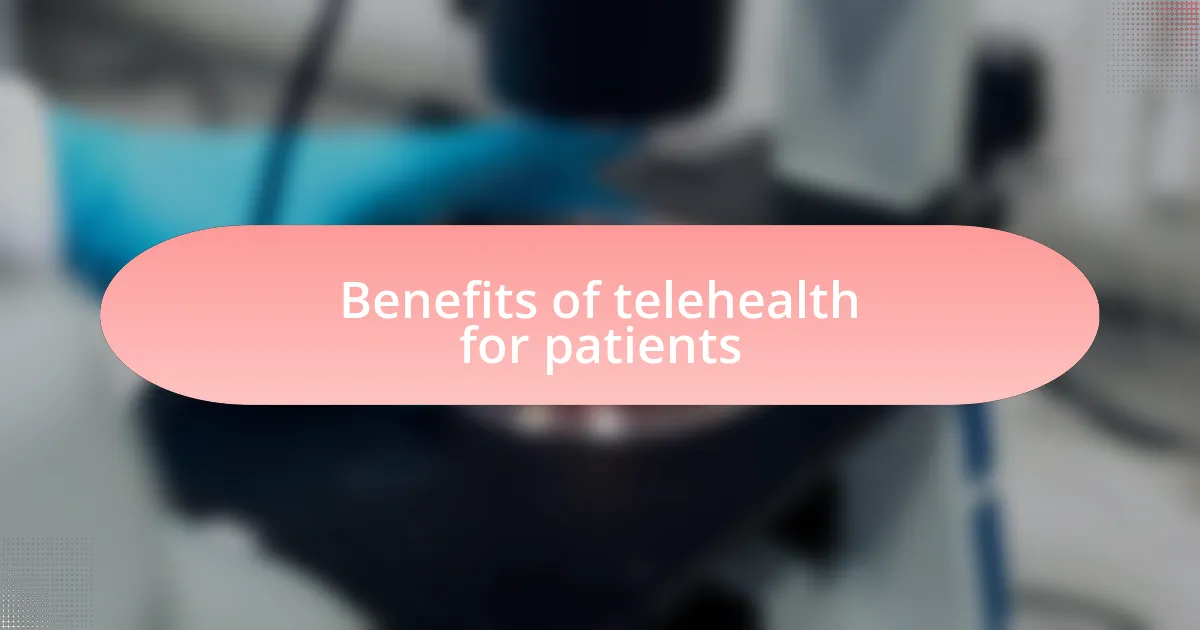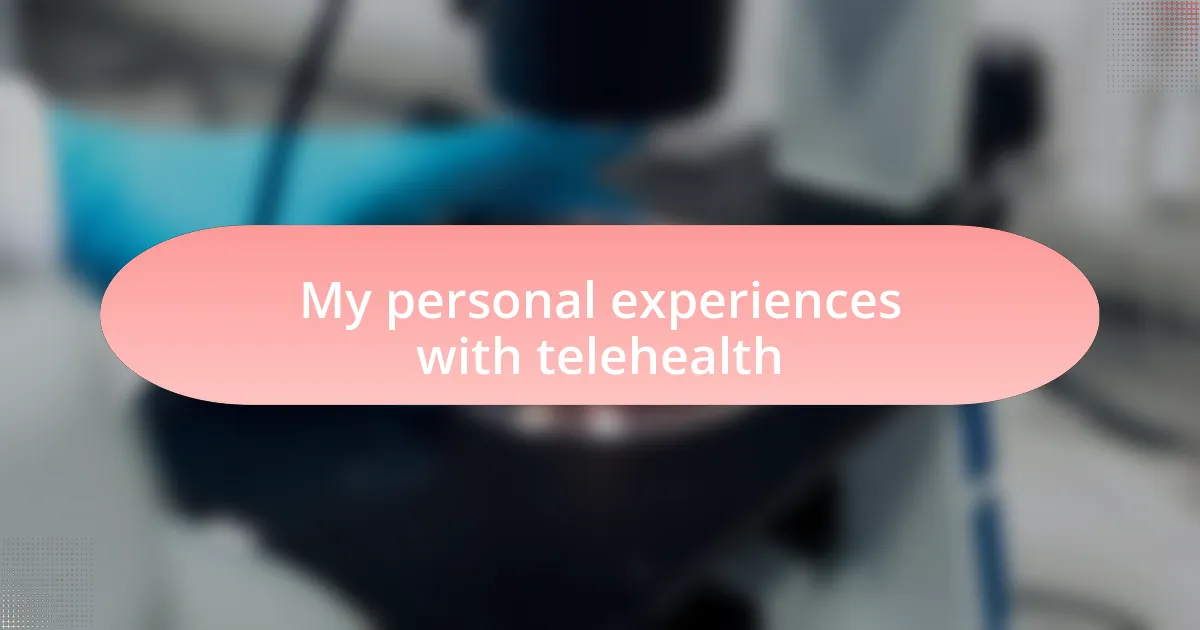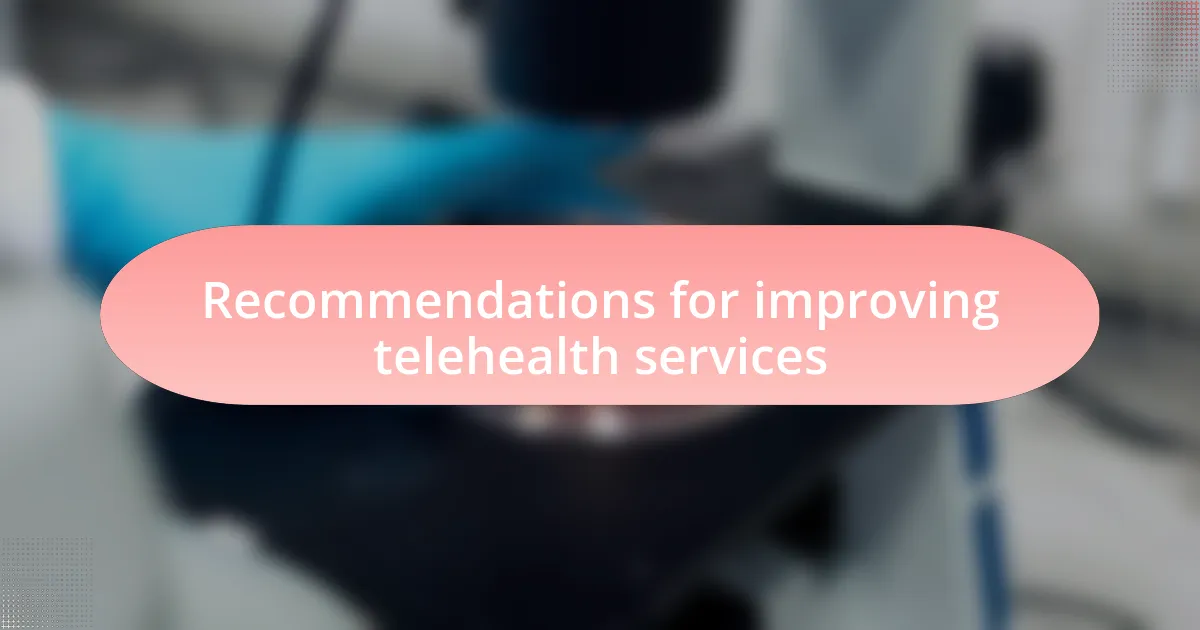Key takeaways:
- Telehealth improves patient accessibility, convenience, and chronic disease management, transforming healthcare interactions.
- Technological advancements, such as AI and wearable devices, enhance telehealth capabilities by providing real-time data and efficient diagnostics.
- Challenges include disparities in technology access, patient privacy concerns, and regulatory hurdles that can inhibit telehealth adoption.
- Improvements can be made through better user interfaces, enhanced internet connectivity, and greater integration of mental health services.

Understanding telehealth in medicine
Telehealth represents a significant shift in how we access medical care, breaking geographic barriers that once limited treatment options. Reflecting on my own experiences, I recall a time when a simple consultation required several hours of travel. Now, with a few clicks, I can connect with a specialist from anywhere, highlighting how telehealth transforms patient accessibility and convenience.
One aspect of telehealth that strikes me is its potential to enhance chronic disease management. I’ve witnessed friends and family struggle with frequent visits to the hospital, often feeling overwhelmed. Imagine the relief of managing their care from the comfort of home while still receiving quality guidance. Isn’t it incredible how technology empowers us to take control of our health in unprecedented ways?
Additionally, the emotional connection can sometimes feel diminished in a virtual setting. I often wonder, does a screen truly replace the empathetic touch of a healthcare provider? Yet, I’ve also experienced virtual consultations where the patient-provider connection was surprisingly robust, showing that while different, telehealth can still nurture trust and compassion effectively.

Benefits of telehealth for patients
Telehealth offers remarkable convenience for patients, allowing them to access healthcare services without the stress of travel. I remember a time when I had to schedule a doctor’s appointment around my work commitments, often sacrificing precious hours. Now, I can attend a consultation during my lunch break or from my living room, saving time and reducing the associated stress of traditional visits.
One of the most profound benefits I’ve noticed is the reduction in wait times for appointments. I once had to wait weeks, if not months, to see a specialist. With telehealth, I can often secure an appointment within days. This rapid access not only alleviates anxiety but also ensures that urgent health concerns are addressed promptly. Isn’t it reassuring to know that you can get the care you need when you need it?
Furthermore, telehealth has broadened the range of specialists available to patients, transforming how we approach healthcare. For instance, I once engaged a nutritionist who specialized in my unique health concerns that weren’t readily available in my local area. Accessing this expertise from a distance empowered me to make informed dietary choices that greatly improved my well-being. It’s astonishing how telehealth can connect you with the right professionals, regardless of geography, paving the way for better health outcomes.

Innovations shaping telehealth future
Innovations in technology are revolutionizing telehealth, and one standout development is the rising use of artificial intelligence (AI) in patient diagnostics. I vividly recall my first experience with an AI-driven symptom checker during a minor health scare. It not only provided a possible diagnosis but also suggested next steps. This immediacy and clarity transformed a moment of anxiety into a straightforward plan, illustrating how AI can enhance our understanding of health conditions without the usual medical gatekeeping.
Another fascinating advancement is the integration of wearable technology, such as smartwatches, into telehealth systems. I remember a friend sharing how his smartwatch alerted him to irregular heartbeats, prompting him to consult his doctor. The immediacy of data sharing with healthcare providers allowed for timely interventions, showcasing a seamless bridge between monitoring and medical advice. How comforting is it to know that your health can be tracked in real-time?
Moreover, virtual reality (VR) and augmented reality (AR) are beginning to find their place in telehealth. I recently participated in a therapeutic session that utilized VR to help me manage stress and anxiety. The immersive experience provided a level of engagement that traditional methods struggled to achieve. It’s exciting to think about how these technologies could reshape therapy and rehabilitation, making healthcare not just more accessible, but also more effective. Wouldn’t it be incredible to step into a virtual space for your next consultation?

Challenges facing telehealth adoption
Adopting telehealth isn’t without its hurdles, particularly when it comes to technology access. I remember speaking with a neighbor who faced significant barriers due to limited internet connectivity in their rural area. This experience highlighted a stark reality: not everyone has the same access to the digital world, which can leave some patients isolated from the advancements in healthcare. How many others are out there who might not have the necessary resources to benefit from telehealth options?
Another challenge lies in the realm of patient privacy and security. A few months ago, while discussing telehealth options with a family member, their skepticism about sharing personal health information online became clear. Concerns about data breaches and the potential for identity theft can deter individuals from engaging fully with telehealth services. I often think about how crucial it is for healthcare providers to establish trust, as it directly impacts their patients’ willingness to embrace virtual care.
Regulatory issues can also complicate telehealth adoption. I recall participating in a webinar where experts discussed the maze of licensing requirements that healthcare providers face when offering telehealth services across state lines. The variability in laws can confuse both providers and patients, potentially leading to gaps in care. How can we streamline these regulations to encourage a more unified approach to telehealth that prioritizes patient access?

My personal experiences with telehealth
One of my first experiences with telehealth was when I had a follow-up appointment for a chronic condition. I remember sitting in my living room, connecting with my doctor over a video call. It was surprising how comfortable it felt; I could discuss my health in my own space. I felt more relaxed than usual, but I wondered if that would still be the case if the tech failed mid-conversation.
During the pandemic, I realized how essential telehealth had become. I vividly recall the moment I set up my first virtual therapy session. The initial awkwardness quickly melted away as I found that talking about my feelings from my own comfortable environment made a huge difference. It struck me then: Can mental health care really thrive in a digital space? The ease of access felt liberating, yet I still questioned if the connection was as strong as it would be in person.
I’ve also had my share of technical challenges. There was a time when I logged into a telehealth visit only to find that my device wouldn’t connect properly. The anxiety that crept in as I scrambled to fix the issue was palpable. It made me reflect on how critical it is for everyone using telehealth to have reliable technology. I still wonder how many patients have been left hanging, missing valuable appointments due to tech glitches.

Predictions for telehealth advancement
As I contemplate the future of telehealth, I can’t help but anticipate its integration with artificial intelligence (AI). Imagine having an AI-powered chatbot conduct preliminary assessments before a consultation. I’ve experienced the benefits of streamlined interactions—could AI take this efficiency to a new level, ensuring that our healthcare needs are met even before we connect with a doctor?
Another advancement I foresee is the use of wearable technology in telehealth. Just recently, I used a fitness tracker to monitor my heart rate during a virtual visit. The ability to provide real-time data while speaking to my healthcare provider was invaluable. Will we soon reach a point where continuous monitoring can alert doctors to potential problems before they escalate? Such proactive measures could redefine how we prevent and manage chronic illnesses.
Furthermore, I think about how telehealth will evolve to address disparities in healthcare access. For instance, I often feel fortunate to live in an area where technology is readily available, but what about those in rural or underserved communities? It’s crucial to ensure that advancements in telehealth also focus on inclusivity. How can we ensure that everyone has equal access to these tools? This will ultimately define the success of telehealth in improving health outcomes for all.

Recommendations for improving telehealth services
One effective recommendation for improving telehealth services is enhancing the user interface of platforms. I remember struggling to navigate a telehealth app during a crucial consultation; it was frustrating and impacted my overall experience. If healthcare providers invested in developing more intuitive designs, I believe patients would feel more comfortable engaging with their healthcare team. Isn’t it essential that these tools are as user-friendly as possible to encourage wider adoption?
Another key area for improvement lies in ensuring robust internet connectivity, especially in rural regions. I’ve spoken to friends who live in less populated areas, and they often share stories of dropped calls or poor video quality during appointments. It’s heart-wrenching to think that technological barriers could prevent someone from receiving timely care. What proactive steps can be taken to enhance connectivity, perhaps through partnerships with local telecom providers?
Additionally, incorporating mental health services into telehealth offerings deserves attention. Personally, I found video therapy sessions surprisingly effective, yet many people remain unaware of the options available. By promoting mental health resources and integrating them into existing telehealth platforms, patients can access comprehensive care without the stigma that sometimes accompanies mental health discussions. How can we create a more supportive environment that encourages individuals to seek help when they need it most?